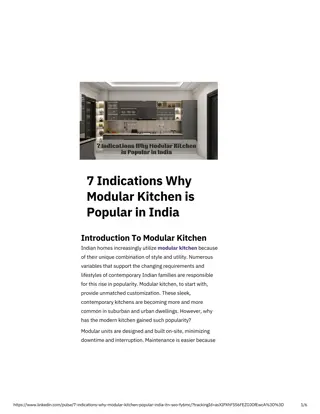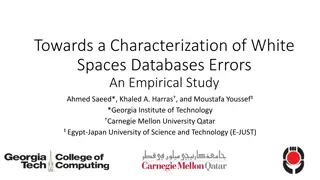Modular Open Systems Approach (MOSA) White Paper Recommendations Summary
"The National Defense Industrial Association (NDIA) Systems Engineering Division's Architecture Committee, chaired by Bob Scheurer, provides key recommendations from their MOSA white paper, focusing on promoting collaboration and innovation in defense and national security projects. The paper outlines top recommendations for success, including insights for government agencies, prime contractors, and the systems engineering community."
Download Presentation

Please find below an Image/Link to download the presentation.
The content on the website is provided AS IS for your information and personal use only. It may not be sold, licensed, or shared on other websites without obtaining consent from the author.If you encounter any issues during the download, it is possible that the publisher has removed the file from their server.
You are allowed to download the files provided on this website for personal or commercial use, subject to the condition that they are used lawfully. All files are the property of their respective owners.
The content on the website is provided AS IS for your information and personal use only. It may not be sold, licensed, or shared on other websites without obtaining consent from the author.
E N D
Presentation Transcript
Modular Open Systems Approach (MOSA) White Paper Recommendations Summary NDIA Systems Engineering Division Architecture Committee Bob Scheurer, Chair July, 2020
Your Presenter: Bob Scheurer Robert (Bob) P. Scheurer, P.E., P.M.P. Boeing Defense, Space, & Security (BDS), St. Louis Systems Engineering / Technical Fellow 37 Years Experience Hardware, Software, & Systems Engineering INCOSE Systems Engineering Certification PMI Project Management Certification MSEE, Washington Univ. in St. Louis BSEE, University of Illinois, Champaign/Urbana Certificate in Open Systems, Washington Univ. in St. Louis Programs: F/A-18, F/A-18E/F, F-15, F-23, FCS, Recent Programs Support: T-X, JMR, MQ-25A, SLAM-ER, VC-25B, Recent Industry / Professional Contributions: IEEE-15288.1-2014 Systems Engineering on Defense Programs (Contrib. Author) IEEE-15288.2-2014 Technical Reviews & Audits of Defense Programs (Contrib. Author) NDIA Systems Architecture Committee (Chair) INCOSE Midwest Gateway Chapter (Current Officer, Held All Offices, incl. President x 3) Project Management Institute, PMP Certification IEEE Standards Association (Boeing Rep., Voting Member) Aerospace Industry Association (NDIA Liaison) 7/13/2024 2
Topics Introduction to National Defense Industrial Association (NDIA), Systems Engineering Division MOSA White Paper, Intended Audience MOSA Background & Terminology Premises for MOSA Success Today Top 10 Recommendations on the Modular Open Systems Approach (MOSA) 3
NDIA Architecture Committee Overview National Defense Industrial Association (NDIA) Promotes the best policies, practices, products and technology to build a more responsive and collaborative community in support of defense and national security NDIA SE Division - Org Chart Architecture Committee Membership: 38 Industry; 14 Gov t; 5 Academia Key focus on MOSA since 2017 MOSA white paper V2 complete Current focus on metrics This presentation captures key recommendations from the Committee s work 4
MOSA White Paper Intended Audience Government Those who determine guidance for executing Contracts and producing System Architectures realized by those contracts Prime Contractors/Suppliers Those who execute the contracts Investment Strategy Considerations Subcontractor Impacts Intellectual Property Ramifications Systems Engineers in Govt. who write the RFP s for acquisitions MOSA requirements RFP Guidance Evaluation criteria Systems Engineering Community Modularity and Openness insights and awareness NDIA Systems Engineering Division, incl. Architecture Team, et. al. Guidance to help with developing the recommendations and changes needed in current policies and guidance Policy recommendations and standards development 7/13/2024 5
Brief Background on MOSA MOSA and Modularity/Open Systems Objectives Date Back Many Decades Slow, Inconsistent Adoption Over the Years Acquirers/DoD Objectives Overcome Risks from Diminishing Supply Chain, Technology Obsolescence Experience Benefits from More Rapid, Competitive Upgrades of Systems Suppliers/Contractors Objectives Overcome Risks to Existing Business Models, Including Proprietary Information Experience Benefits from Broader, More Enduring Business Base 7/13/2024 6
Todays MOSA: In Simple Terms MOSA: Modular Open Systems Approach is an integrated business and technical strategy that employs a modular design with defined interfaces between modules and if available and suitable, uses open interfaces that are defined by widely supported standards. 7/13/2024 7
Government/Acquirer Goals for MOSA Increased interoperability between systems and ability to develop new missions through composition and reuse Increased innovation and ability to quickly integrate new capabilities Increased competition between suppliers due to open interfaces Reduced cost and increased buying power Faster and better defined technology refresh capabilities Simplification of the acquisition process 7/13/2024 8
Defense Industrial Base Goals for MOSA More competitive products through lower cost structures Faster time to market, with less development time and costs Increased competition within supply chain for lower costs Increased interoperability providing greater market opportunities Structured upgrade paths for quicker tech refresh and longer product life spans Foundation for greater commonality across products, and larger lot buys for reduced costs through modularity Incentive to innovate via an improved IP policy, by allowing access to and integration of critical supplier IP while still protecting supplier business interests and investments 7/13/2024 9
NDIA White Paper: Premises for MOSA Success Today A. Government and industry need to work together to define a MOSA implementation for mutual benefits A structured approach is needed in responding to congressional language mandating the use of MOSA Properly implemented MOSA can provide numerous benefits: increased competition, reduced costs and new synergistic capabilities and missions MOSA is an enabler on which Mission Engineering, Digital Engineering and System Security Engineering can build Understanding how to apply open interfaces is critical in fostering innovation, competition, and protection of Intellectual Property. B. C. D. E. 7/13/2024 10
Conclusions and Recommendations 1) Develop MOSA strategy early in acquisition process Understand reason and objectives for MOSA and its application on an acquisition Define supplier success and how MOSA will be evaluated Define MOSA partitioning at a level above the planned procurement system How does the planned acquisition fit into adjacent systems or other platforms? What interfaces are needed for adequate Mission Engineering? Which standards need to be used for interfaces to other systems? What standards are missing or need development? Demonstrate understanding of financial and performance justification for planned partitioning Explicitly state MOSA objectives and desired outcomes, along with the strategy/plan for getting there at all appropriate levels Provide MOSA strategy early in acquisition cycle to allow contractors to plan technology investments
Conclusions and Recommendations 2) Define MOSA implementation approach (Acquirer and supplier roles) Define level of MOSA addressed, planned partitioning, requisite functionality, interfaces to be controlled/open and the domain in which commonality is desired, as well as the objective for MOSA implementation (adaptability, sustainability, upgradeability, competition, etc.) for each level of design Consider incentives for implementing MOSA in order to facilitate acceptance by acquirers and suppliers Define OSD policy and regulations for implementing Technical Data Rights and Intellectual Property (those areas impacted by MOSA) Develop MOSA architecture at level being procured along with governance of planned open interfaces Plan for design disclosure of common modules needed to enable second sourcing and competition Identify common standards or release of ICDs and other documents that define open interfaces Define methods for sharing program information and interfaces across services, programs and security levels 7/13/2024 12
Conclusions and Recommendations 3) Define Interfaces in Terms of MIL-STD-881D Taxonomy Levels of Detail MIL-STD-881D is important for establishing a common language Provides consistent approach to defining hierarchy within a system or System of Systems Needs to be employed consistently Define levels of taxonomy/modularity to eliminate ambiguous terms such as major component and platform level Consider System Taxonomy breakdown of the Nomenclature system Mil-STD- 196F/G (System, Subsystems, Centers, Centrals, Sets, Group, Units) for related taxonomic conventions Define level of integration (Manual, type of automation, etc.) expected between platforms, systems, subsystems, and components at all applicable levels in the SoS s Taxonomy
Conclusions and Recommendations 4) Apply MOSA in software architectures at appropriate levels of abstraction and complexity Apply MOSA requirements appropriate to software architecture levels of abstraction / reification (provide form to), including the SoS level Develop a software taxonomy similar to MIL-STD-881D to guide development of software MOSA. Especially focus on modularity in software and standard interfaces Define a Framework/Lexicon to enable discussion of the design level with appropriate partitioning at various levels and stages of design along with associated logical interfaces. Develop a common reference architecture for data model identification at varying levels of fidelity, including applicability of various partitions in the various DoD Domains Define modular software data rights at appropriate levels of modular abstraction/reification (OS vs. micro-services)
Conclusions and Recommendations 5) Implement MOSA as part of a larger and more robust Digital Engineering strategy Models can be used to define and communicate MOSA architectures and partitioning Development of a common MOSA framework/lexicon needs to be tasked to define System Functions at multiple levels of an architecture (Instance data at the next levels below the DoDAF Meta Data of Performer and System). System and SoS Architecture definition and management responsibility need to be articulated at the government and mission level, with flow-down to contractors and procurement items. Standards, common modules and interfaces should be categorized as to their level in the SoS taxonomy and technology state (old, latest implemented, emerging, etc.), then placed in a reference architecture
Conclusions and Recommendations 6) Incorporate cybersecurity strategy in a MOSA application at the time of initial design, not as a later addition System Security Engineering needs to be performed up-front as part of the development process (when identifying CONOPS and declaring security requirements) Understand effects of modularity and open interfaces on cybersecurity and system security Understand possible MOSA-induced threat vectors and associated risks Develop security architecture early in the program and define risk mitigation approaches 7/13/2024 16
Conclusions and Recommendations 7) DOD and industry work together to define how to evaluate MOSA and certify as MOSA compliant Define MOSA metrics for various domains and SOS levels Establish MOSA evaluation process and evaluation criteria for proposals Define what it means to be MOSA compliant and develop standard certification objectives and criteria Emphasize measurement methodology over structure (One set of metrics for one domain, such as ship building, may not be appropriate for a different domain, such as aerospace) 7/13/2024 17
Conclusions and Recommendations 8) Develop and implement enablers with appropriate investment to effect culture change required for successful widespread adoption of MOSA: Includes OSMP, MOSA in Technical Reviews, and MOSA Strategy Defined at all levels of the system Make MOSA a requirement -- not an option -- for all procurements Open Systems Management Plan as common as a SEMP MOSA incorporated into technical/management reviews A common approach to functional analysis is needed to define partitioning MOSA strategy defined at all levels of the system of systems Include explicit MOSA principles in all architectures Include MOSA as a primary consideration in Value Engineering Government needs to coordinate across services and weapon systems as to specifications, standards, and mission engineering Provide a means for sharing interfaces and data between programs Embed MOSA in System/Mission/Digital Engineering and SoS processes Build MOSA incentives into contracts and award fee structures Services and DoD should ensure effective management and coordination of the various MOSA-enabling standardization efforts
Conclusions and Recommendations 9) Create library of MOSA certified systems and interfaces Maintain re-useable archive of systems that are certified MOSA systems and interface types identified as certified MOSA interfaces MOSA-compliant systems are made available for reference and follow-on improvement Includes the system partitioning architecture as well as the ICDs and standards for the open interfaces defined in the system, providing traceability to the driving requirements and processes in the Operational Architectures. Include the modularity objectives, how those objectives were achieved, and why they are important Facilitate development of common, open architectures, providing access to critical information that will 1) help accelerate MOSA adoption, 2) speed a system s development, and 3) increase competition across industry 7/13/2024 19
Conclusions and Recommendations 10) Define a means for comparing and specifying standards and interfaces for a MOSA-enabled environment Develop method to talk about and compare standards Critical for gap analysis Develop a common method of assigning interfaces or types of interfaces to an architecture Identify tool that can be used by program managers and other stakeholders to determine appropriate standards to use Map standards interfaces to MIL-STD-881D
Summary Key benefits from a MOSA implementation Weapon system interoperability and scalability Technology refresh and new technology insertion Reduced cost Reduced development cycle for new capabilities Increased competition Improved sustainment and life cycle costs Key MOSA enablers Development of key standards and interfaces Detailed Service implementation plans and consistent application Formal and standard way of assessing MOSA implementations Transition to a MOSA culture and environment 7/13/2024 21
Appendix 7/13/2024 22
MOSA in a Nutshell MOSA is an integrated business and technical strategy that employs a modular design with defined interfaces between modules and if available and suitable, uses open interfaces that are defined by widely supported standards. Use of open interfaces can foster competition and reduce system costs for the acquirer. Use of standards for open interfaces also allows a standardized verification process to ensure interfaces are correctly implemented across different platforms and among different developers. Contractors and suppliers stand to gain as well, largely from increased business opportunities that a uniform MOSA application will provide. A modular architecture defines the levels of design where functionality is partitioned into discrete, self-contained units with well-defined interfaces. The best modules typically are ones that have a high functional cohesion within the module and a loose coupling between modules at the interfaces. This then permits substitution of similar modules from alternate sources with minimal impact on the overall system. Such an architecture allows for increased competition and innovation and can provide cost savings, faster deployment of new capabilities and a well-defined path for system upgrades and technology refresh. MOSA can also provide for increased system interoperability, and in so doing, facilitate Mission Engineering and more capable Systems of Systems which more rapidly adapt to new threats and emerging technologies. These principles can be applied at all levels of the systems, from a top level system of systems, mission level to lower level, sub tier components. However, as identified in this white paper and the associated recommendations, it is vitally important that MOSA implementations be tailored for the specific level of system interest in order to maximize the probability of successful outcomes. 7/13/2024 23























